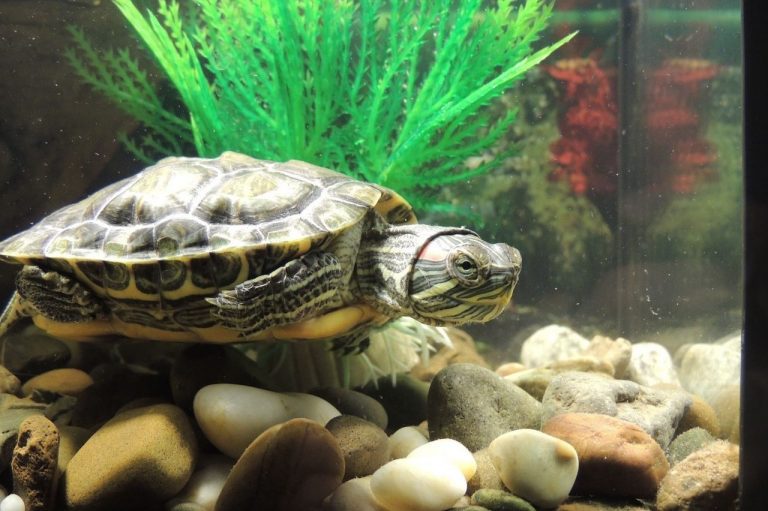How Long Can A Turtle Stay Out Of Water?
Today we discuss How Long Can A Turtle Stay Out Of Water. Turtles are fascinating creatures that can thrive in both land and water. While they are known for their aquatic skills, have you ever wondered how long turtles can stay out of water? In this post, we will explore the world of turtles and their abilities on land and in water. Join us as we uncover the secrets of turtle survival.
How Long Can A Turtle Stay Out Of Water:
Anatomy and Adaptations:
Turtles are unique reptiles with specialized anatomical features that enable them to thrive in various habitats.
Their shells, for instance, offer protection and act as a vital adaptation for survival. The shell consists of two parts: the carapace (the upper portion) and the plastron (the lower portion).
This bony structure not only acts as armor but also helps with buoyancy control in the water.
Land Adaptations:
While turtles are well-equipped for aquatic life, they possess certain adaptations that allow them to survive on land for extended periods.
One such adaptation is their ability to breathe air. Unlike fish, turtles have lungs and must come to the surface to breathe. This adaptation enables them to spend time outside of water without suffocating.
Aquatic Adaptations:
Turtles are primarily aquatic creatures, and their bodies are designed to thrive in water environments. Their streamlined bodies, webbed feet, and strong limbs make them excellent swimmers.
Additionally, turtles have a cloaca, which functions as a reproductive and excretory organ. The cloaca allows turtles to efficiently eliminate waste while swimming, further enhancing their aquatic abilities.
Factors Affecting Time Spent out of Water:
The duration that a turtle can spend out of water depends on various factors. These factors can influence a turtle’s ability to survive in terrestrial environments. Let’s explore some of the significant factors below:
Species:
Different turtle species have varying degrees of adaptability to different habitats. Some species are more terrestrial and can survive longer periods out of water, while others are more dependent on aquatic environments.
For example, terrestrial tortoises can spend the majority of their lives out of water, while aquatic turtles such as red-eared sliders are more reliant on water sources.
Age:
The age of a turtle can also impact its ability to stay out of water. Younger turtles typically require more moisture and are less adapted to terrestrial life compared to older individuals.
As turtles mature, they develop better adaptations for surviving extended periods away from water.
Environment:
The surrounding environment plays a crucial role in determining how long a turtle can stay out of water. Factors such as temperature, humidity levels, and availability of shelter affect a turtle’s ability to regulate its body temperature and prevent dehydration.
Turtles that live in arid regions may have more difficulty surviving extended periods outside of water compared to those in more humid environments.
Health and Hydration:
The overall health and hydration of a turtle are significant factors in its ability to tolerate time away from water.
A well-hydrated and healthy turtle will be better equipped to withstand arid conditions compared to a dehydrated or sick individual. Proper nutrition and access to freshwater sources are essential for maintaining a turtle’s health.
Terrestrial Activities of Turtles:
While turtles are primarily associated with aquatic habitats, they do engage in various terrestrial activities. Understanding these activities can give us insights into how long turtles can stay out of water.
Basking:
Basking is a common behavior observed in many turtle species. It involves turtles sunning themselves on logs, rocks, or other elevated surfaces. Basking serves multiple purposes, including thermoregulation, vitamin D synthesis, and parasite control. Turtles may spend several hours basking, but eventually, they will return to the water to prevent dehydration.
Nesting:
Female turtles leave the water to lay their eggs in nests dug on land. The duration they spend on land during nesting varies depending on the species. Some turtles may only be on land for a few hours, while others may remain on land for several days until the nesting process is complete.
Seasonal Migration:
Certain turtle species undertake seasonal migrations between different habitats. These migrations can involve traversing overland for significant distances. While turtles may spend considerable time on land during these migrations, they eventually return to their preferred aquatic habitats.
Duration Turtles Can Stay Out of Water:
The length of time that turtles can stay out of water varies depending on the factors mentioned earlier. Let’s explore some examples:
Semi-Aquatic Turtles:
Semi-aquatic turtles, such as red-eared sliders and painted turtles, can spend several hours or even days out of water. They have adaptations that allow them to retain moisture for longer periods, reducing the risk of dehydration.
Terrestrial Turtles:
Terrestrial turtle species, like tortoises, have evolved to spend most of their lives on land. They can go months without access to water sources since they obtain most of their needed moisture from the vegetation they consume.
Aquatic Turtles:
Aquatic turtles have a higher dependency on water due to their streamlined bodies and adaptations for swimming. While they can tolerate short periods out of water for activities like basking or nesting, they must return to water within a reasonable time frame to maintain their well-being.
Importance of Water for Turtles:
While turtles can spend time away from water, it is crucial to acknowledge the significance of water for their survival.
Hydration:
Water is essential for maintaining proper hydration levels in turtles. Dehydration can lead to significant health issues and even death in severe cases.
Turtles rely on both external sources (such as ponds, rivers, or lakes) and internal hydration (from their food) to meet their water requirements.
Thermoregulation:
Water plays a vital role in thermoregulation for turtles. It allows them to cool down their bodies during hot weather by submerging themselves or seeking shade near water bodies.
Conversely, turtles also rely on basking in the sun or warming themselves on rocks near the water to raise their body temperature when they need it.
Feeding and Hunting:
Many turtle species require water to hunt for food effectively. Aquatic turtles feed on various prey found in their habitat, such as small fish, insects, and amphibians. Water provides them with the opportunity to pursue and capture their prey efficiently.
Conclusion:
Turtles are incredible creatures that can adapt to both land and water. While their ability to live on land depends on factors like species, age, environment, health, and hydration levels, water is essential for their well-being. Understanding these factors and the importance of water in their lives helps us appreciate these fascinating reptiles. Remember, turtles are primarily water creatures who occasionally venture onto dry land.




